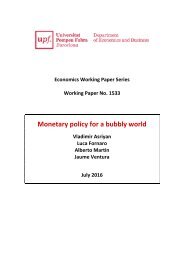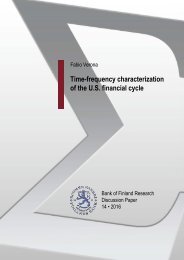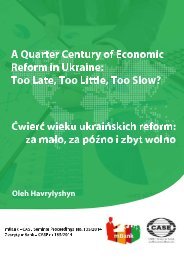Necessity as the mother of invention monetary policy after the crisis
n?u=RePEc:dnb:dnbwpp:525&r=mac
n?u=RePEc:dnb:dnbwpp:525&r=mac
You also want an ePaper? Increase the reach of your titles
YUMPU automatically turns print PDFs into web optimized ePapers that Google loves.
ate, <strong>the</strong>reby constraining any nominal interest rate to be positive. After decades during<br />
which rates were nowhere near zero, interest in (and worries regarding) <strong>the</strong> lower bound<br />
resurfaced in <strong>the</strong> 1990s, <strong>as</strong> Japan continued to struggle with low growth and deflation.<br />
Presciently, Paul Krugman (1998) <strong>as</strong>ked: “could a liquidity trap happen to <strong>the</strong> European<br />
Monetary Union?” Ten years later, this question w<strong>as</strong> no longer hypo<strong>the</strong>tical. Since <strong>the</strong>n<br />
many central banks have approached, and several have breached, <strong>the</strong> “zero lower bound.”<br />
How comfortable have central bankers become with <strong>policy</strong> rates near or even below<br />
zero? Our survey shows <strong>the</strong>re is still some hesitance. For <strong>the</strong> full list <strong>of</strong> unconventional<br />
instruments, we <strong>as</strong>ked:<br />
Once conditions return to normal, do you think each <strong>of</strong> <strong>the</strong> following should remain a<br />
potential instrument <strong>of</strong> <strong>monetary</strong> <strong>policy</strong>, remain an instrument but in modified form, be<br />
discontinued, or that it is too early to judge?<br />
Regarding <strong>policy</strong> rates near or below zero, <strong>the</strong> results are shown in Table 4.<br />
Table 4. Policy rates in <strong>the</strong> new normal<br />
Governors Academics Chi-sq.<br />
All AEs vs. all vs. AEs<br />
Policy rate(s) near zero (NG=32, NA=157) 36.3*** 12.6***<br />
Remain potential instrument 43.8 69.2 73.3<br />
Remain, but in modified form 3.1 0.0 2.6<br />
Be discontinued 9.4 0.0 18.5<br />
Too early to judge 43.8 30.8 5.8<br />
Negative rates (NG=32, NA=156) 27.1*** 14.9***<br />
Remain potential instrument 21.9 38.5 52.6<br />
Remain, but in modified form 0.0 0.0 2.6<br />
Be discontinued 25.0 7.7 31.4<br />
Too early to judge 53.1 53.9 13.5<br />
Notes: Figures denote percentage <strong>of</strong> respondents (ei<strong>the</strong>r central bank governors or academic<br />
economists). *** denotes significance at <strong>the</strong> 1% level, calculated using Chi-square tests for <strong>the</strong><br />
independence <strong>of</strong> <strong>the</strong> responses <strong>of</strong> governors and academics. NG and NA denote <strong>the</strong> number <strong>of</strong><br />
responding governors and academics. Source: Authors’ calculations b<strong>as</strong>ed on survey conducted in<br />
2016.<br />
When <strong>as</strong>ked about <strong>the</strong> potential future use <strong>of</strong> <strong>policy</strong> rates near zero, more than 40% <strong>of</strong><br />
<strong>the</strong> governors say it is “too early to judge.” This finding is somewhat surprising, and may<br />
suggest that some still see zero <strong>as</strong> very much a lower bound. In fact, in response to <strong>the</strong><br />
question on negative rates, only 22% would still use <strong>the</strong>m should circumstances arise.<br />
Only around 22% <strong>of</strong> <strong>the</strong> responding governors have considered negatives rates in recent<br />
years, while 10% decided not to implement <strong>the</strong>m (see Table 3). The academics are,<br />
perhaps naturally, less cautious. More than 70% think rates near zero should be used again,<br />
and more than 50% feel negative rates should be in <strong>the</strong> tool-kit (Table 4). These differences<br />
between governors and academics are among <strong>the</strong> starkest that we find in <strong>the</strong> survey<br />
responses, no matter whe<strong>the</strong>r we focus on all governors in <strong>the</strong> sample or on those from<br />
15








